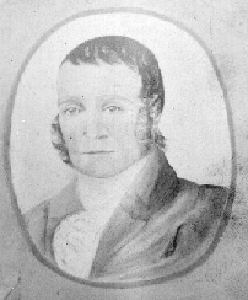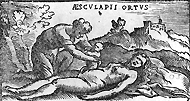Who was the first doctor to perform a successful Cesarean section?
 January 14, 1794 — Dr. Jessee Bennet (July 10, 1769—July 13, 1842) performed the first successful Cesarean section operation today — on his wife, Elizabeth.
January 14, 1794 — Dr. Jessee Bennet (July 10, 1769—July 13, 1842) performed the first successful Cesarean section operation today — on his wife, Elizabeth.
Earlier that day, Elizabeth endured a prolonged labor and her doctor — Dr. Humphrey — with Bennett determined the only options were a Caesarean section on Elizabeth or a craniotomy on the unborn infant. Dr. Humphrey refused to do anything, feeling that either operation meant certain death for both the mother and her infant. History tells us that Dr. Humphrey then left the Bennett home.
Desperate to save her child, Elizabeth begged her husband to perform the C-section. Dr. Bennett assembled a crude operating table from two boards supported by barrels, and gave his wife laudanum to make her sleepy. Two servants supported her on the table while Elizabeth’s sister held a candle to light the operating table.
Dr. Bennett cut his wife’s abdomen with a single sweep of his knife and extracted his infant daughter, Maria. He then removed both of Elizabeth’s ovaries, saying he’d “not be subjected to such an ordeal again.” Finally, he sutured the surgical wound with stout linen thread, the kind used in frontier homes to sew heavy clothing.
Elizabeth recovered and was able to be up a month later. Dr. Bennett declared his wife healed as of March 1, 1794, writing a cryptic case history on the title page of one of his medical books. Elizabeth lived for 36 more years, passing away on April 20, 1830. Maria Bennett lived until 1870, married twice, and bore six children.
Sources
Words of Wisdom
Did you know: Cesarean section has been part of human culture since ancient times and there are tales in both Western and non-Western cultures of this procedure resulting in live mothers and offspring. According to Greek mythology Apollo removed Asclepius, founder of the famous cult of religious medicine, from his mother's abdomen.
Numerous references to cesarean section appear in ancient Hindu, Egyptian, Grecian, Roman, and other European folklore. Ancient Chinese etchings depict the procedure on apparently living women. The Mischnagoth and Talmud prohibited primogeniture when twins were born by cesarean section and waived the purification rituals for women delivered by surgery.
Image (above): The extraction of Asclepius from the abdomen of his mother Coronis by his father Apollo. Woodcut from the 1549 edition of Alessandro Beneditti's De Re Medica.





